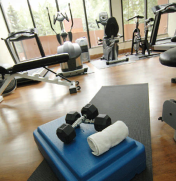This blog was written by Veronica HofMann. Meet our blogging fitness specialists at the NIFS website.
 Many people spend a majority of their time at work. This is where we go each day, and while we are there we have plenty to keep us busy. After we leave, we also have work to do—making dinner, cleaning house, and caring for the kids. So how can we possibly squeeze in one more thing? We all know how important exercise is, but many times it falls to the bottom of our “to-do” lists...until now.
Many people spend a majority of their time at work. This is where we go each day, and while we are there we have plenty to keep us busy. After we leave, we also have work to do—making dinner, cleaning house, and caring for the kids. So how can we possibly squeeze in one more thing? We all know how important exercise is, but many times it falls to the bottom of our “to-do” lists...until now.
Many employers are bringing exercise to the workplace. With new worksite wellness programs for employees, they are encouraging folks to be active even while sitting at their desks! Portable pedal machines, which are similar to a mini stationary bike, can be placed under a desk so that you can exercise even while sitting at the computer.
Employers are also encouraging walking groups, giving instruction on how to exercise at your desk, and offering pedometers to employees so that they can track their progress.
This kind of worksite health promotion program is a way to encourage even the most sedentary individuals to get moving! Time is what we all need more of. If our employers encourage us to exercise while we work, it would be easier for people to begin and stick to an exercise routine. This may even encourage people to continue to exercise outside the workplace.
Even if this is not something your employer suggests, there are many things you can do on your own. A few examples are
- Go on a walk after lunch.
- Take the stairs.
- Exercise in the break room.
With enough participation, you could even negotiate a group rate at your local health club. Some clubs even offer a lunchtime membership!
What have you done at your job to encourage exercise?

 fitness, I’ve seen firsthand how beneficial corporate fitness centers and company wellness programs can be. Today I’ll take a look at three of the top reasons why utilizing your company’s corporate fitness center is a no-brainer.
fitness, I’ve seen firsthand how beneficial corporate fitness centers and company wellness programs can be. Today I’ll take a look at three of the top reasons why utilizing your company’s corporate fitness center is a no-brainer. e main problem is that fat as a fuel source is not the same thing as burning fat off of your body. Fat burning has more to do with the total amount of calories burned than the type of energy your system uses.
e main problem is that fat as a fuel source is not the same thing as burning fat off of your body. Fat burning has more to do with the total amount of calories burned than the type of energy your system uses. Sleep and exercise can be a vicious cycle. The more tired you are, the less motivation you have to exercise. Working in a corporate fitness program, I see a lot of tired and stressed people. The onsite fitness facility seems to help improve their moods.
Sleep and exercise can be a vicious cycle. The more tired you are, the less motivation you have to exercise. Working in a corporate fitness program, I see a lot of tired and stressed people. The onsite fitness facility seems to help improve their moods.
 The Benefits of an Exercise Break
The Benefits of an Exercise Break product, my first instinct is to investigate further. Did I miss out on inventing yet another ingenious fitness product? Am I going to think "Why didn't I think of that?" There are a plethora of fitness products that I should have invented, including the
product, my first instinct is to investigate further. Did I miss out on inventing yet another ingenious fitness product? Am I going to think "Why didn't I think of that?" There are a plethora of fitness products that I should have invented, including the  Turns out that corporate fitness programs might have a leg up on those Sharpies. According to a
Turns out that corporate fitness programs might have a leg up on those Sharpies. According to a  In the pursuit of my Exercise Science degree, one of my college courses dealt with exercise leadership. We learned how to plan a group fitness class and manage all the dynamics that went into it, music included. We learned what tempos are best for warm-ups, which beats are motivating for the bulk of the exercise, and which styles of songs are conducive for cool-down periods.
In the pursuit of my Exercise Science degree, one of my college courses dealt with exercise leadership. We learned how to plan a group fitness class and manage all the dynamics that went into it, music included. We learned what tempos are best for warm-ups, which beats are motivating for the bulk of the exercise, and which styles of songs are conducive for cool-down periods.